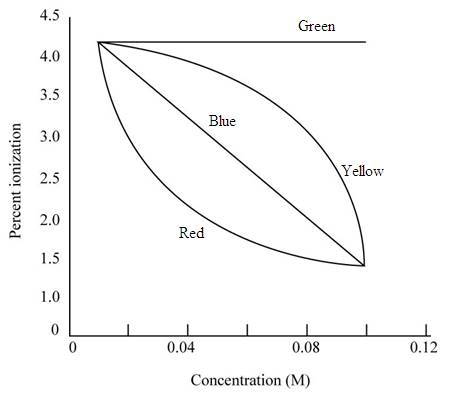
Concept explainers
Interpretation: The line in the given Figure that best represents the dependence of the degree of ionization of acetic acid on its concentration in aqueous solution is to be stated.
Concept introduction: Degree of ionization is defined as the ratio of the number of molecules ionized in an aqueous medium to the total number of molecules dissolve in the aqueous medium. The measure of concentration of ions in a solution gives the ionic strength of the solution.
To determine: The line in the given Figure that best represents the dependence of the degree of ionization of acetic acid on its concentration in aqueous solution.
Answer to Problem 15.1VP
Solution
The red line best represents the nature of acetic acid.
Explanation of Solution
Explanation
The given figure is,

Figure 1
The given acid is acetic acid which is a weak acid. The degree of ionization is inversely proportional to the square root of molar concentration according to Ostwald’s dilution law.
In the given graph, the green line shows that there is no effect of concentration on the degree of ionization. Therefore, it is not applicable for an acetic acid. The yellow line shows a tremendous change in the degree of ionization by the change in concentration, this does not happen for a weak acid like an acetic acid.
Therefore, it does not represent acetic acid. The blue line represents the change in degree of ionization by the change in concentration in a continuous manner. In a weak acid, the change in degree of ionization is not continuous. Thus, it also does not represent acetic acid. The red line shows that the degree of ionization increases with the decrease in concentration of an acid.
Thus, the red curve represents the degree of ionization for the acetic acid.
Hence, in all the lines shown in Figure 1, red line best represents the nature of acetic acid.
Conclusion
The red line best represents the dependence of the degree of ionization of acetic acid on its concentration in aqueous solution.
Want to see more full solutions like this?
Chapter 15 Solutions
EBK CHEMISTRY: THE SCIENCE IN CONTEXT,
- V Biological Macromolecules Drawing the Haworth projection of an aldose from its Fischer projection Draw a Haworth projection of a common cyclic form of this monosaccharide: H C=O HO H HO H H OH CH₂OH Explanation Check Click and drag to start drawing a structure. Xarrow_forwardComplete the mechanismarrow_forwardComplete the mechanismarrow_forward
- 8 00 6 = 10 10 Decide whether each of the molecules in the table below is stable, in the exact form in which it is drawn, at pH = 11. If you decide at least one molecule is not stable, then redraw one of the unstable molecules in its stable form below the table. (If more than unstable, you can pick any of them to redraw.) Check OH stable HO stable Ounstable unstable O OH stable unstable OH 80 F6 F5 stable Ounstable X Save For Later Sub 2025 McGraw Hill LLC. All Rights Reserved. Terms of Use | Privacy C ཀྭ་ A F7 매 F8 F9 4 F10arrow_forwardJust try completing it and it should be straightforward according to the professor and TAs.arrow_forwardThe grading is not on correctness, so if you can just get to the correct answers without perfectionism that would be great. They care about the steps and reasoning and that you did something. I asked for an extension, but was denied the extension.arrow_forward
 ChemistryChemistryISBN:9781305957404Author:Steven S. Zumdahl, Susan A. Zumdahl, Donald J. DeCostePublisher:Cengage Learning
ChemistryChemistryISBN:9781305957404Author:Steven S. Zumdahl, Susan A. Zumdahl, Donald J. DeCostePublisher:Cengage Learning ChemistryChemistryISBN:9781259911156Author:Raymond Chang Dr., Jason Overby ProfessorPublisher:McGraw-Hill Education
ChemistryChemistryISBN:9781259911156Author:Raymond Chang Dr., Jason Overby ProfessorPublisher:McGraw-Hill Education Principles of Instrumental AnalysisChemistryISBN:9781305577213Author:Douglas A. Skoog, F. James Holler, Stanley R. CrouchPublisher:Cengage Learning
Principles of Instrumental AnalysisChemistryISBN:9781305577213Author:Douglas A. Skoog, F. James Holler, Stanley R. CrouchPublisher:Cengage Learning Organic ChemistryChemistryISBN:9780078021558Author:Janice Gorzynski Smith Dr.Publisher:McGraw-Hill Education
Organic ChemistryChemistryISBN:9780078021558Author:Janice Gorzynski Smith Dr.Publisher:McGraw-Hill Education Chemistry: Principles and ReactionsChemistryISBN:9781305079373Author:William L. Masterton, Cecile N. HurleyPublisher:Cengage Learning
Chemistry: Principles and ReactionsChemistryISBN:9781305079373Author:William L. Masterton, Cecile N. HurleyPublisher:Cengage Learning Elementary Principles of Chemical Processes, Bind...ChemistryISBN:9781118431221Author:Richard M. Felder, Ronald W. Rousseau, Lisa G. BullardPublisher:WILEY
Elementary Principles of Chemical Processes, Bind...ChemistryISBN:9781118431221Author:Richard M. Felder, Ronald W. Rousseau, Lisa G. BullardPublisher:WILEY





